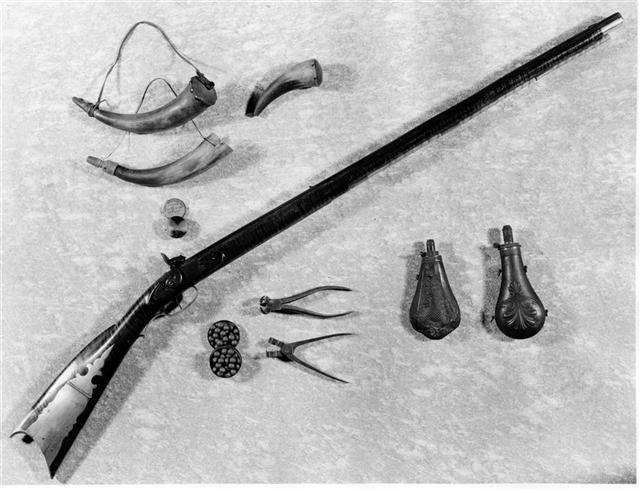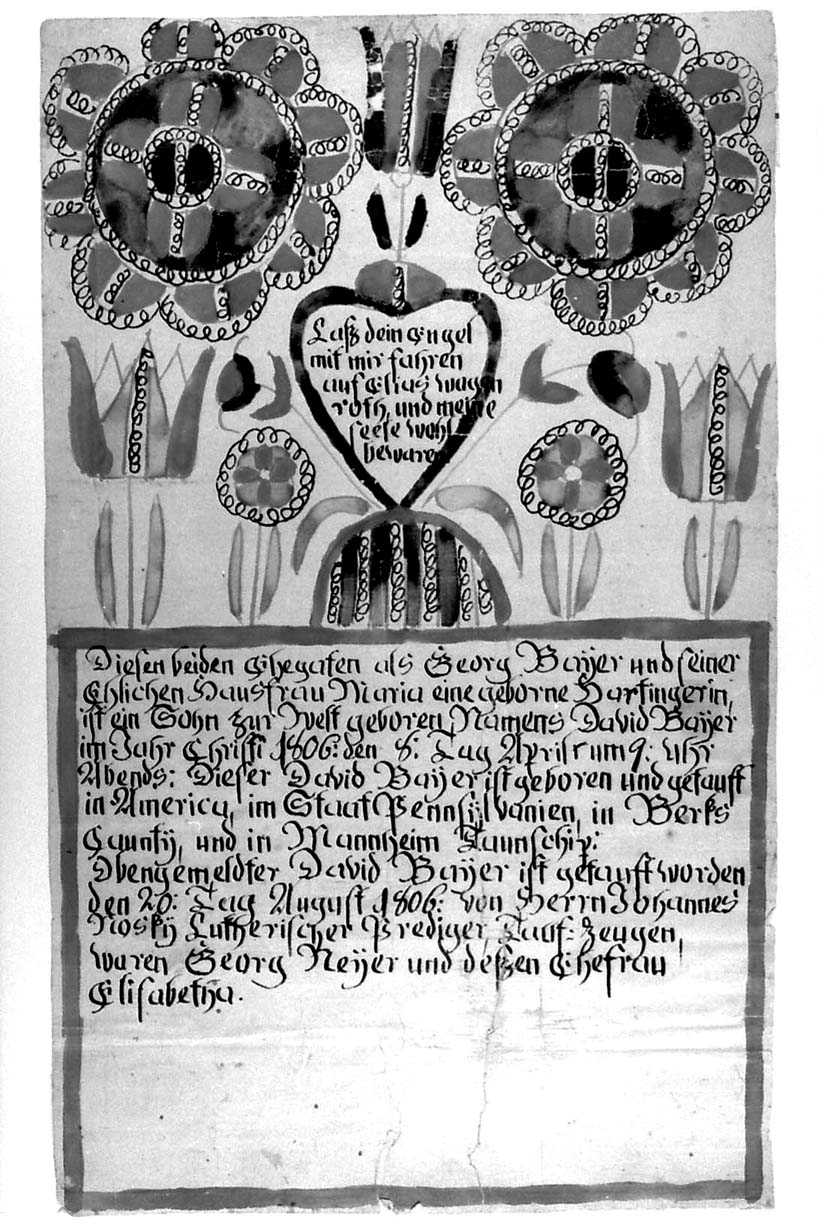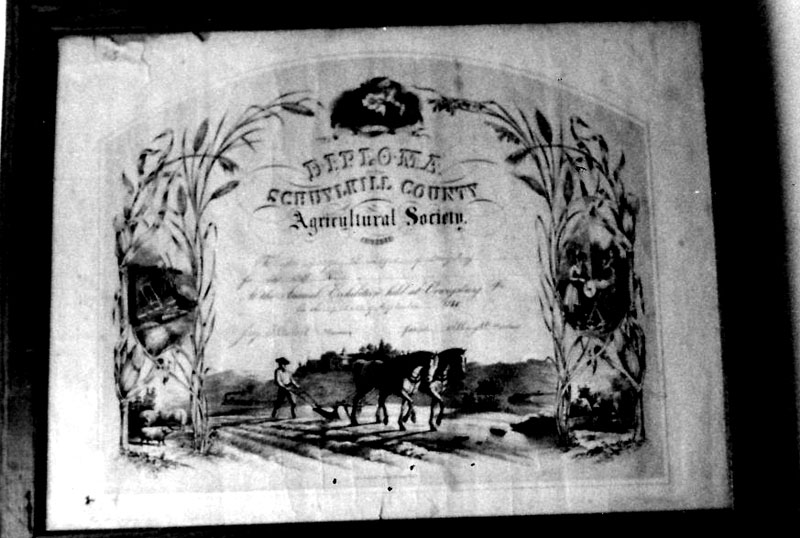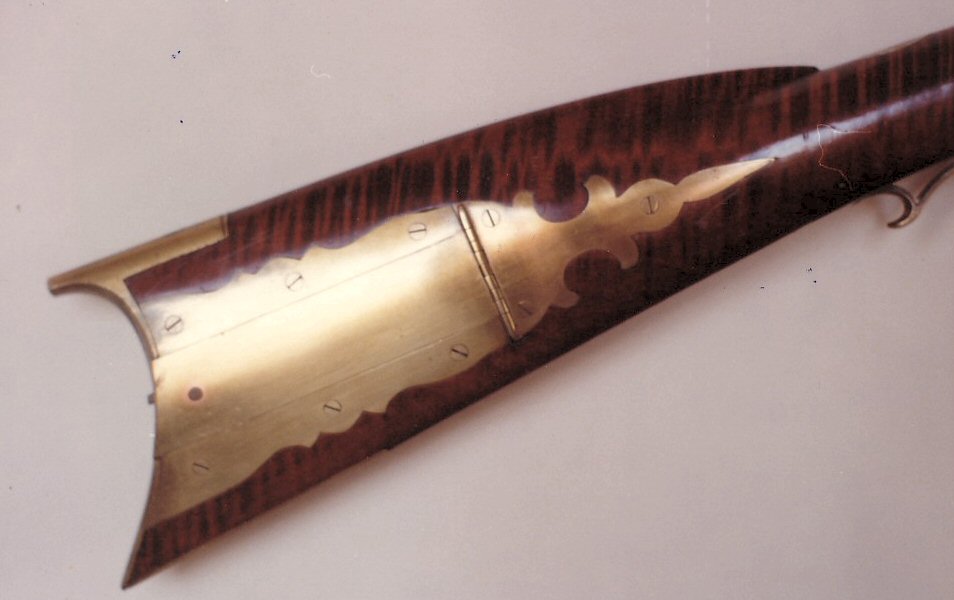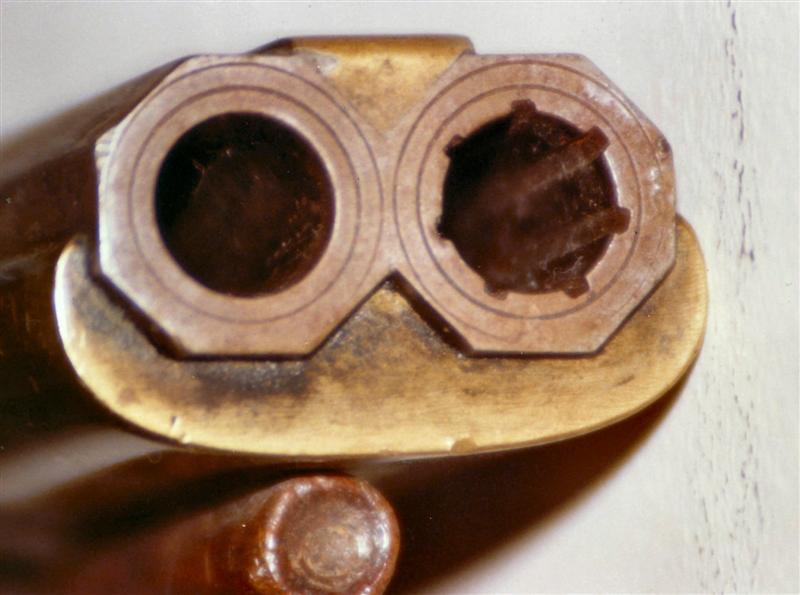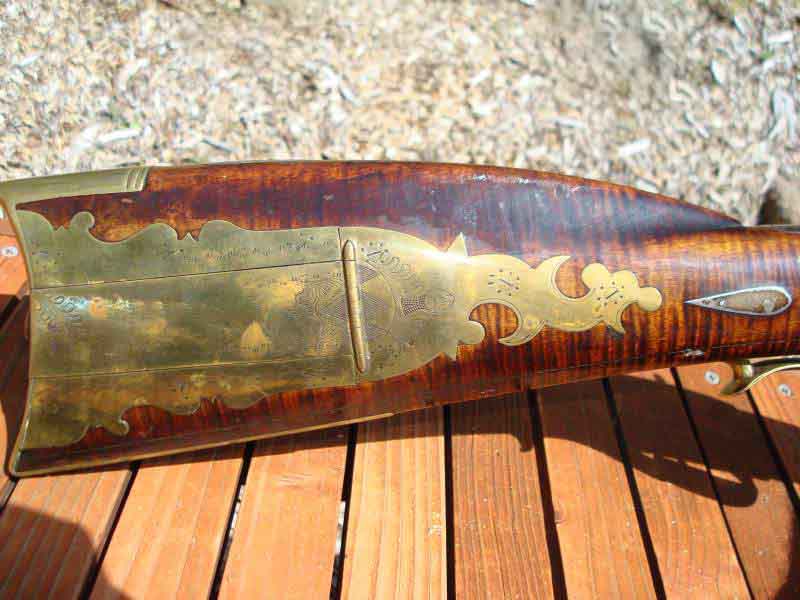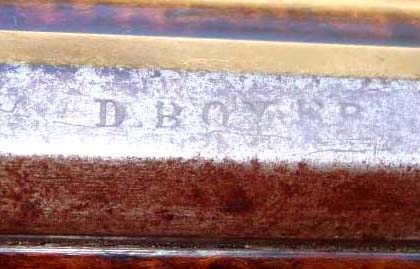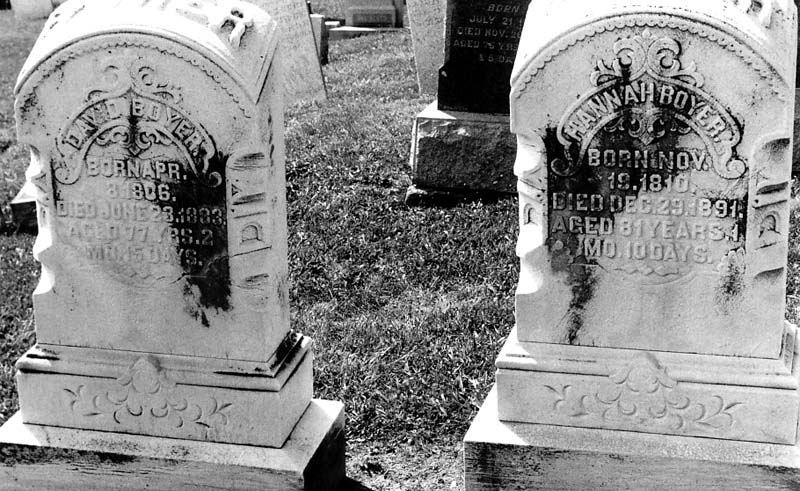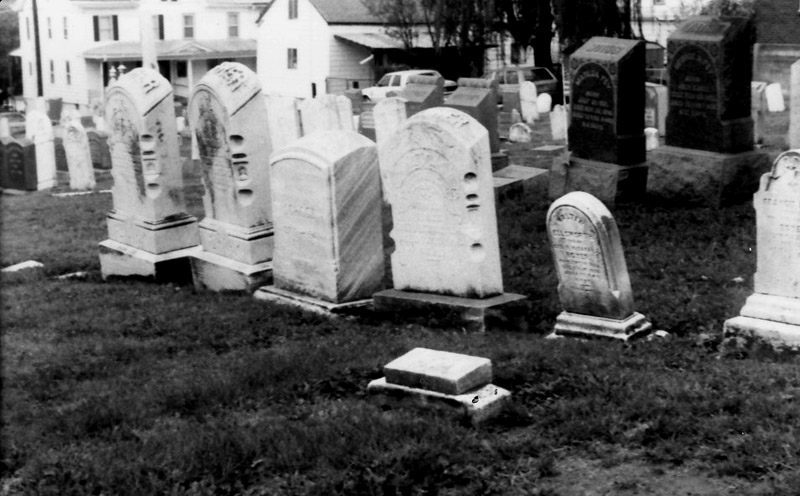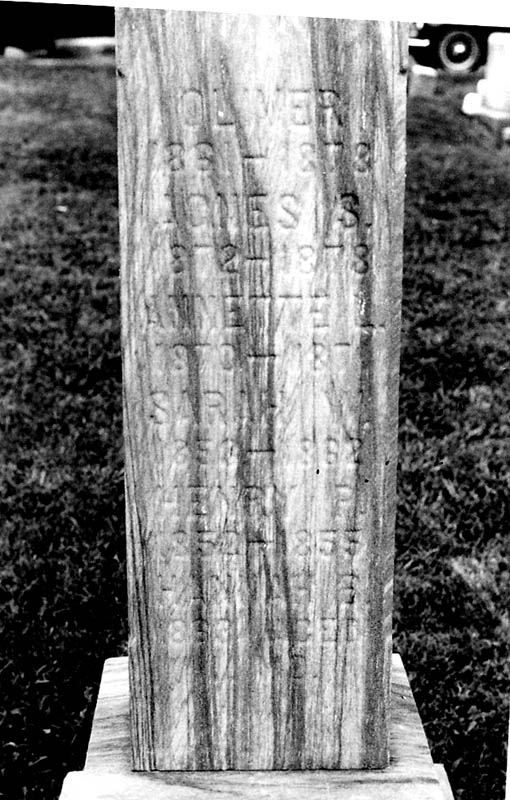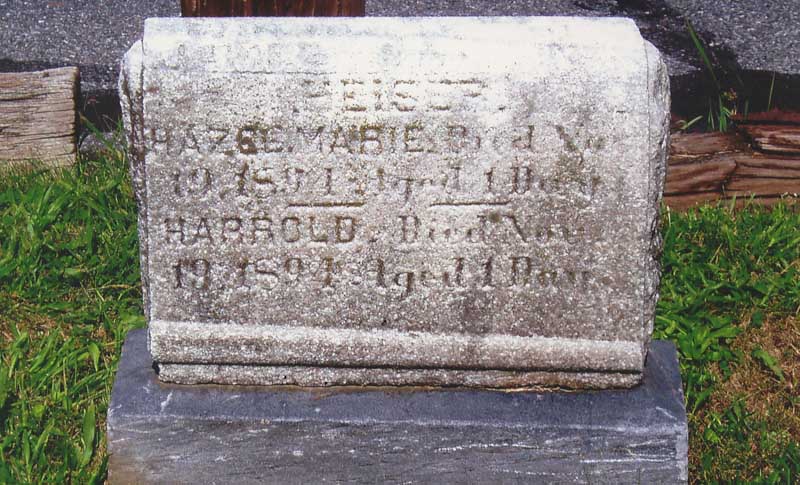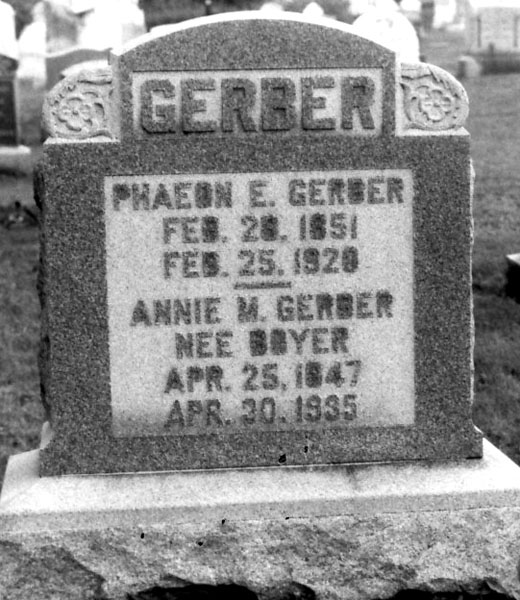|
Revised
Third Generation: The Family of David Boyer, 1806-1883 Gunsmith of Orwigsburg, Pennsylvania
The fourth child of George and Anna Maria Boyer, the grandfather of Lewis Elmer Boyer, was named David Boyer. David was born, according to his baptismal certificate, in Manheim Township, on the 8th of April 1806, at the hour of 9 in the evening. The certificate, written in German and hand illuminated, said that the baptism was performed by the Lutheran pastor.[1] David was baptized at the Red Church on August 10, 1806. It was just two years after his grandfather, Johann Friedrich Boyer, had been buried from the same church. David was a gunsmith, the maker of a long rifle known as a "Pennsylvania-Kentucky" rifle (see photo above). One gun known to be made by David was stamped "D. Boyer," and some gun experts believe that other guns stamped "D. Boyer" may also have been made by David of Orwigsburg. Others point out that there may have been two people named D. Boyer who made guns at various times, the first one around 1800, making rather rustic flintlock rifles, and the second one around 1840, using a cap percussion system and showing superior craftsmanship. Some experts also think that D. Boyer the gunmaker may have lived in Reading, Pennsylvania, while others believe he spent his entire life in Orwigsburg, 30 miles north of Reading, also in Berks County. (Orwigburg was included in the new Schuylkill County when Berks County was divided in 1811.) The sections below provide information on David Boyer's role as a gunsmith in Orwigsburg and on his two wives and his nine children. They also discuss the debate over whether there were one or two gunmakers who signed their work "D. Boyer," and whether these gunmakers lived in Reading or Orwigsburg. David Boyer's children were: 1. Joseph Boyer (1829-1908) 2. Violetta Boyer (Schock) (1832-1904) 3. Lawrence Boyer (1837-?) 4. Matilda Boyer (Jenkins) (Dietrich) (Elliot) (1838-?) 5. George B. Boyer (1839-1907) 6. William B. Boyer (1843-1925) 7. Marie Barbara "Annie" Boyer (Gerber) (1847-1935) 8. Charles Boyer (1850-1869) 9. Thomas B. Boyer (1854-1857). David Boyer's Family Genealogical Charts LINKS: Boyer Family of Orwigsburg Home Page Association of American Boyers The Immigrant Johann Friedrich Boyer Children of Johann Friedrich Boyer The Boyer Family of Easton, Pennsylvania Waltman Family of Northampton County David Boyer, the Gunsmith David was a maker of a long rifle known in some quarters as a “Pennsylvania Kentucky” rifle. One of his guns passed down through the hands of the oldest child in each generation of the Lewis Elmer Boyer family, and in 2008 it was in the possession of Karen Lloyd, the daughter of Floyd Elwood Boyer, Jr., in Florida. The rifle is stamped "D. Boyer." It is believed that the "best rifle" award of the Schuylkill County Agricultural Society in 1860 was for a gun made by David, possibly this same gun. The certificate was made out to David's son George B. Boyer, but George was only 20 at the time and it is believed he was exhibiting his father's work product. David was then 54, presumably a prime age for the production of high-quality guns. The David Boyer rifle that was passed down through the Lewis Elmer Boyer family (possibly a different gun but probably the same) won the "first premium" award for "best antique firearm" when it was entered into the Kentucky State Fair in 1974 by Floyd Elwood Boyer, Jr., a great-great-grandson of David.
It was reported that David also made a gun for his son Charles, who died at the age of 19 in 1869. That gun -- said to have been marked with wild turkeys forming a cross -- was given to another son of David, William B. Boyer, after Charles died. William's son Robert Boyer remembered that the gun was in the possession of his father all of his life. When William died in 1925, it was understood that that gun was passed on to a grandson, Elwood Eckert, the son of Mary (Mame) Boyer Eckert. However, in 1987, Elwood’s daughter Lillian Eckert Haring, of Belvidere, his only known survivor, said she had no knowledge of a “Boyer Gun” in the family.[2] Thus, the trail to that particular gun apparently has been lost. Lillian Haring died on November 16, 2008 at the age of 90. Other Guns by "D. Boyer." There is no known gun that bears the inscription "David Boyer," but there has been considerable interest among gun collectors and other parties interested in long rifles that have been signed or stamped "D. Boyer." Some believe there were at least two individuals making guns who signed them "D. Boyer," and some believe that the "D. Boyer" who made guns came from Reading, Pennsylvania, rather than from Orwigsburg, which is 30 miles to the north. Some of the rifles were thought to have been made around the year 1800, and these were distinguished from the ones made about 1840-1860. The later guns were considered to be of a higher degree of professionalism, while the earlier guns were more rustic, without decorative brass plating, intended for practical use around a farm. Other analyses of the Pennsylvania long rifle may be found here and here. Some of the more rustic guns were called "Schimmel" rifles, and several Schimmel rifles have been located bearing the inscription "D. Boyer.". One expert provided this explanation for this type of rifle:
Among the guns that have been located bearing the inscription "D. Boyer," there is no first name firmly established as associated with the "D." Some believe the name is David, apparently basing it on David, the known gunmaker of Orwigsburg, and some believe it could be Daniel. Apparently, the only "D. Boyer" clearly identified as a gunmaker is the David Boyer who is the subject of this chapter. As indicated in the text below, this David, who was born in 1803 and died in 1883, is identified as a "gunsmith" in the census reports for Orwigsburg in 1860, 1870 and 1880. The 1860 report called him a "master gunsmith." But if there were "D. Boyer" guns being made about 1800, they would not have been made by the David Boyer of Orwigsburg, who would have been too young (not even born) at that time. The Kentucky Rifle Association Bulletin, Volume 30, Number 3, of Spring 2004, contained a long article titled "David Boyer, Schimmel Rifles of Berks County." This included photographs of a number of rifles stamped "D. Boyer," in much the same pattern (see photo below) as the signature on the gun known to have been made by David Boyer of Orwigsburg, the focal point of this chapter. However, the article presented no evidence that the "D" in these signatures stood for David. An example of the view that there were two people named "D. Boyer" is a study reporting that in the collection of the Western Pennsylvania Historical Society, in Pittsburgh, there was at one time a gun carrying the inscription "David Boyer, Orwigsburg," engraved in script letters on the lid of the patch box.[3] The author examined numerous records and published this conclusion (the text contains a number of errors but is presented here as indicative of the research that has appeared about this gunmaker): David Boyer’s name first appears in the assessment records of the Borough of Orwigsburg in the year 1837. He owned a house and a lot but no description of his occupation is included. At later dates he acquired six valuable units of real estate, mostly with improvements on them; some of these are described as being located in the sprawling country side of North Manheim Township, adjoining the borough. Records indicate that Orwigsburg propered at mid-century, for it was the county seat, not far from the Philadelphia-Sunbury turnpike, and was near the busy water course of the Schuylkill Canal. In this prosperity Boyer seems to have shared. Since no will or administrative record appears in the court house, some form of intestacy must be presumed, or he may have moved from the county. David Boyer is thought to have been a second generation gunsmith, although no documentary data on an earlier one exists. That some guns of an earlier period are attributed to a craftsman named Boyer is the main source of information in this matter. Both the earlier Boyer and David were specialists in the making of over-and-under guns. Both makers made fine guns that were typical of their period and are eagerly sought by collectors. [4] Note: David Boyer’s tombstone in Orwigsburg, and the baptisms of his children, indicate that he did not leave town, as suggested by the author of this study. And while there might have been a contention that David was a second-generation gunsmith, no evidence has been located to show that his father George or his grandfather Johann Friedrich Boyer made guns. A 1905 report on David's son William B. Boyer said that although David was indeed a gunsmith, he did that work only for a brief number of years. In later years, it was said, he lived on a farm he had purchased and was a leading citizen of the community. The study said that David was a deacon in the Lutheran church and at one time held the office of councilman.[5] (The reference to the farm in this section also seems inaccurate, because census and church records are quite clear that David lived, at least for his last 50 years, within the town of Orwigsburg. David was listed among those who took communion at St. Paul's Lutheran Church in 1847 and also from 1880 to 1882, the year before he died. His wife Hannah was also listed at the church in 1845 and 1846, as well as from 1880 to 1887. The suggestion that David was a councilman has not been confirmed, although it would seem logical considering his apparent prominence in the town.)
More
Sightings of the Boyer Rifle. In
1986, there was a "Boyer Rifle" on display in Washington at
the Smithsonian Institution's National Museum of American History, on
the third floor in the ordnance section (it was no longer there in
2005). In a general description of the Kentucky Rifle, the display
said: To meet the conditions of hunting and warfare in America, Swiss and German settlers in Pennsylvania altered the massive jaeger rifle of their homelands. The resulting weapon was lighter, long barreled, and more accurate. First known as the Pennsylvania rifle, it later achieved fame as the Kentucky rifle because of its use by frontiersmen such as Daniel Boone. Under a long weapon entitled the "Boyer Rifle," the Smithsonian display said: This double barreled weapon, made about 1800 by Daniel Boyer of Arwigsburg, Pa., could be used as either rifle or shotgun because one barrel was rifled and the other smooth. The barrels were rotated into firing position by releasing a hinged catch forward of the trigger guard. They were fired by a single lock of English make.  The
"over and under" flintlock gun in the museum came
from the collection of Ralph G. Packard, reportedly a wealthy,
world traveling hunter. It had a caliber of 0.45, barrels of
36
inches, and a length of 52 inches. The "over and under" gun had two
barrels that could be rotated into position for firing. The gun itself
was engraved "D.
Boyer." Question has been raised as to whether this gun might
not actually be the work product of David Boyer of Orwigsburg, and
not “Daniel Boyer.” In 1986, a museum specialist at
the
Smithsonian said he was certain that the gun on display there, an
outstanding specimen, had been made in the "golden age of the
Kentucky Rifle," which ran from 1790 to 1810, and therefore
could not have been made by the David Boyer of Orwigsburg born in
1806. The
"over and under" flintlock gun in the museum came
from the collection of Ralph G. Packard, reportedly a wealthy,
world traveling hunter. It had a caliber of 0.45, barrels of
36
inches, and a length of 52 inches. The "over and under" gun had two
barrels that could be rotated into position for firing. The gun itself
was engraved "D.
Boyer." Question has been raised as to whether this gun might
not actually be the work product of David Boyer of Orwigsburg, and
not “Daniel Boyer.” In 1986, a museum specialist at
the
Smithsonian said he was certain that the gun on display there, an
outstanding specimen, had been made in the "golden age of the
Kentucky Rifle," which ran from 1790 to 1810, and therefore
could not have been made by the David Boyer of Orwigsburg born in
1806. Another Boyer gun – a 0.45 caliber Pennsylvania Kentucky flintlock rifle, was purchased by Nancy Boyer Sandt and her husband Wayne Sandt, of Easton, Pennsylvania, in 2005. It too was stamped “D. Boyer” in block letters on the top barrel flat. This was a single barrel gun, 54 1/4 inches long with a smooth barrel 39 1/4 inches long. The single barrel was described as full octagon, 0.45 caliber. In contrast to these guns, the David Boyer gun that in 2008 was in the possession of descendants of Floyd Elwood Boyer, Jr., had two barrels "side by side," with one smooth round barrel and one shaped as a heptagon. It was not a flintlock gun but was fired by a cap on top of the percussion system, indicating that it was made at a later time. (Gun experts report that few if any flintlock rifles were made after 1840.) Also engraved "D. Boyer" (see photo at left), it was 48 inches in length, with a barrel of 33 3/4 inches, weighed 10 pounds, and contained brass trim on curly maple wood. Upon examination of photographs of the gun, the expert said that the David Boyer gun was superior in craftsmanship to the one in the Smithsonian collection, but that also reflected the fact that it was undoubtedly made much later than the one at the Smithsonian. It was probably made in the late 1840s. This conclusion appears to bolster the contention of gun historians that there was a different "D. Boyer" who made guns around 1800, possibly in the Orwigsburg area.[6] At least one study offered the hypothesis that early American gun makers were descended from craftsmen in Europe and that the gun-making skills were transported across the Atlantic. An example is given of a rifle made in Germany "by a member of the Boyer family" which was "almost identical to a detail on a rifle made by D. Boyer of Pennsylvania." The author said this similarity in itself proved nothing, but he hoped it would inspire further investigation of the European roots of Kentucky rifle makers[7]. If this thesis should prove out, it could mean that the two immediate ancestors of David, his father George and even the immigrant Johann Friedrich Boyer, were also gunsmiths, but there is no other report to substantiate this idea.
Is there a "Daniel Boyer, Gunmaker"? Tracings of the Boyer family have not turned up any "Daniel Boyer" or "D. Boyer" who was making guns in Orwigsburg about 1800. There is a report that David's cousin Daniel, the son of Johann Friedrich's second son, Frederick, was a gunsmith, but he was also born too late to have made guns around 1800. That Daniel was born about 1811 in Schuylkill County and moved to Maumee, Ohio, and later to Gratiot County, Michigan, where he died in 1874.[8] Johann Gottfried, the tenth child of Johann Friedrich Boyer, had a son named Daniel, who was born March 30, 1812, in Schuylkill County and died on October 25, 1884, in Ohio, but there is no information that he was a gunsmith. Michael Boyer, the fourth child of Johann Friedrich, had a son named Daniel, born in 1785; he could have been making guns around 1800, but there is no evidence that he had that trade. Also, it appears that David himself had a brother Daniel, born in 1799. Thus, there were at least four cousins named Daniel Boyer, born within 26 years of each other, but none of these seems to be the man making guns a generation before David Boyer. As indicated in previous chapters, there were also other Boyer lines in Orwigsburg, and the record books and cemeteries are replete with people named "Daniel Boyer." But there is no further evidence that any of them was a gunsmith. The only other indicator that there was another Boyer gun maker appears in the 1850 census for North Manheim Township, where a Benjamin Boyer, age 30 (thus born in 1820), is described as “gun smith.” According to the census, Benjamin was the son of John (a shoemaker) and Kate Boyer, age 50 and 48, and the brother of Daniel, 26, Henry, 24, and Abraham, 20. However, the relationship of this John Boyer and his son Benjamin to this branch of the Boyers has not been discovered. There was a report that another "Boyer gun" hung for years over the mantle in the Daniel Boone House in Birdsboro, Pennsylvania, but in the 1970s it was stolen. (A representative of Daniel boon House said in 2005, however, that it was true that an antique gun had been stolen, but he was not certain it was a Boyer gun.) One further Boyer gun sighting emerged in 2008 with discovery in California of an "over and under" rifle, not a "side by side," with an overall length of 47 1/2 inches and a barrel length of 32 inches. The gun was described as "over and under" with one hammer, like the one in the Smithsonian Institution described above. If the trigger guard was pulled while the trigger was cocked, the barrels could be rotated manually until the desired barrel was at the top and clicked into firing position. This gun, with elaborate filigree on the brass plating, was stamped "D. Boyer," much like the others, but it also contained words that appeared to be "Reading PA," thus giving support to those who believe there was a Boyer gun maker who lived there. Another word was stamped on the gun near the word "Reading," but it has been found illegible (see photo below). It must be said, however, that review of census reports for the Reading area reveals no gunmaker with the name Boyer. Unfortunately, the information provided in census reports around 1800 contained only limited information, and occupation was not part of what was provided. Below are photos of the California gun, which may be contrasted with the Orwigsburg gun above.
Conclusions? It is clear there was definitely a David Boyer who lived in Orwigsburg and made long rifles. Did he leave Orwigsburg? Did he make guns in Reading? Or is there another "D. Boyer" who made guns, either in Reading, or around 1800, who is not getting the credit he deserved? Here is a short chronology of the life of David Boyer of Orwigsburg: April 8, 1806 Born in Mannheim Township, near Orwigsburg August 10, 1806 Baptized, Red Church, Orwigsburg 1829 Son Joseph Boyer born in Orwigsburg 1830 Census shows David's father but apparently not David, then 24 1832 Daughter Violetta born in Orwigsburg 1836 David buys property in Orwigburg, twice 1837 Son Lawrence born in Orwigsburg 1838 Daughter Matilda born in Orwigsburg 1839 Son George Boyer born in Orwigsburg 1840 Census shows David, master gunsmith, living in Orwigsburg 1843 Son William Boyer born in Orwigsburg 1847 Daughter Annie born in Orwigsburg 1847 Took communion in St. Paul's Church, Orwigsburg 1850 Census shows David living in Orwigsburg 1850 Son Charles born in Orwigsburg 1850 David does not appear in the census 1854 Son Thomas reportedly born in Orwigsburg 1854 David buys more land in Orwigsburg 1860 Census shows David, gunsmith, living in Orwigsburg 1860 Son George, 20, wins prize for best rifle at Schuylkill County fair 1866 Son Charles confirmed in Orwigsburg 1869 Son Charles buried at Orwigsburg 1870 Census shows David, gunsmith, living in Orwigsburg 1870 St. Paul's Lutheran Church records show David a "faithful Lutheran" 1880 Census shows David, gunsmith, living in Orwigsburg 1883 David dies, is buried in Orwigsburg Many of the published reports on a gunsmith named "David Boyer" or "D. Boyer" appear to contain errors, given the lack of clear identification. There is no indication in the list above that David left Orwigburg at any time. Nevertheless, it is possible that he spent some time in Reading, which is 30 miles to the south, probably a ride on horseback of one or two days in this era and probably not too difficult. While there is no evidence to back this up, one may speculate that David left Orwigsburg to go to Reading to learn the gunsmith trade, and that this resulted in the words "Reading PA" being appended to one or more of his rifles. No other "D. Boyer," gunsmith, appears in census records of Orwigsburg and none at all in Reading. If there were earlier "D. Boyer" guns, made around 1800, they must have been made by someone else. However, several have pointed out that the lettering in "D. Boyer" on these guns appears interestingly similar, including a small tail on the right side of the Y on some of the guns, suggesting that all of the stamping was done by the same person. Information is welcome from anyone who can contribute to the solution of the mystery. Note: Wikipedia contains a section on the Boyer Rifle which includes other information, some of it is at variance with the presentation here. The Wikipedia page links back to the discussion here. David Boyer’s Family David was married twice. He first married Susannah Montgomery, who had one child, Joseph Boyer. After Susannah’s early death, David married Hannah Beck, and they had eight children. No further information could be developed on Susannah, and the marriage is reported only in American Boyers. It is not known when she was born or when she died. We can presume that she was about the same age as David, who was born in 1806. It is likely they were married before their son Joseph was born in 1829, and Susannah must have died before David married Hannah. Hannah’s first child was born in 1832. Thus, Susannah must have died between 1829 and 1832, possibly in childbirth when Joseph was born.
Hannah Beck was born on November 19, 1810, judging by the age given on her tombstone, and was thus four years younger than David. She came from Carbon County, according to one report.[9]The 1830 census for Manheim Township shows the family of David’s father George Boyer, but David, who was then 24, is not among them. Possibly David was not then living with his parents, for the 1830 census also showed the household of a David Boyer in neighboring Brunswick Township, next to Orwigsburg. This included one male between 20 and 29 (presumably David), and one female between 30 and 39 (possibly Susannah). There was no listing of a male under 5, although Joseph, born in 1829, was then 1. And the census report also showed one female between 10 and 15, one female between 5 and 10, and six girls under 5, and these eight children are a mystery. Possibly they were offspring of others in his family. Or perhaps this was another David Boyer entirely. The 1840 census shows David’s father George still in Manheim Township, and David is not with him. But in 1840, the census shows the household of David Boyer in Orwigsburg (apparently David had moved into town from Brunswick Township). That census showed one male between 30 and 40, one female between 20 and 30, one male between 20 and 30 (perhaps an error in age by the census-taker), two females between 5 and 10, and two males under 5. These could have been David Boyer, who was then 34, David’s second wife Hannah, who was then 29, possibly David’s son Joseph (although he would have been only 11), and David and Hannah’s children Violetta, 8; Matilda, 5; Lawrence, 3; and George B. Boyer, less than a year. No record of the David Boyer family could be located in the 1850 census. This is unfortunate, since that census, for the first time, recorded the family members by name and age. David must have continued to live in Orwigsburg, however, judging by other documents around that time. The Schuylkill County record books contain several transactions concerning his land acquisitions. On January 26, 1836, when he was 30, David paid $149 to Jacob Huntzinger, Jr., for a one story log dwelling and lot in the town of Orwigsburg; the site was not described in the deed. Ten months later, on November 10, 1836, he paid $33 to William Potts for lot number 129 on Tammany Street in Orwigsburg, the second lot from the intersection of Warren and Tammany Streets. What it was like in 1836 is unknown. In 1986, that intersection was at the top of a steep hill, with small private homes on three corners and a large knitting mill on the fourth. On August 10, 1854, when he was 48, David paid $43 to Henry Beyer for a one acre triangular piece of land in Orwigsburg, bounded by land already owned by David, next to land owned by the estate of James Price, and by the Orwigsburg Middleport Road; it is possible that this land adjoined the property at Warren and Tammany Streets.[10] In 1860, David reappears in the census, and this family is recorded: David Boyer, 53, master gunsmith, owner of real estate valued at $500 and personal property valued at $200 Hannah Boyer, 50 Violetta Boyer, 24 George Boyer, 20, apprentice gunsmith William Boyer, 17 Anna Boyer, 13 Charles Boyer, 9 The 1870 census seemed to show that all but one of David’s children had gone off on their own. It recorded this family: David Boyer, 63, gunsmith, owner of real estate valued at $2,000 and personal property valued at $300. Hannah Boyer, 59, keeping house (cannot read or write) Annie Boyer, 21 George Faust, 17 (possibly a grandson) Annie Jenkins, 10 (child of David's daughter Matilda). The 1880 census recorded this family: David Boyer, 74, gunsmith Hannah Boyer, 69, wife, keeping house Annie Jenkins, 20, granddaughter, single.[11]
On August 30, 1841, David paid $10 for a large family Bible, printed in Munich, Germany, in 1798, and bound with heavy leather straps. In 1986, that Bible was in the custody of Donald J. Boyer of Easton, great-grandson of David's son William B. Boyer. The Bible contained only limited family information, It did include reference to the confirmation of David's son Charles B. Boyer on December 24, 1866, at the Reformed Church in Orwigsburg (three years before Charles died), and a receipt for taxes of $15 paid to James W. Kaiser in Orwigsburg on May 16, 1889 (six years after David's death). David died on June 23, 1883, at the age of 77 years, 2 months, and 15 days, according to his tombstone and according to the burial record at St. Paul's Evangelical Lutheran Church in Orwigsburg, which notes in the margin that he was "a faithful Lutheran." Hannah died eight years later, on December 29, 1891, at the age of 81 years, 1 month and 10 days. Their tombstones, labeled "Father" and "Mother," are easily found in the northwest corner of the Old Lutheran Cemetery, among many other Boyer tombstones.[12] Although David was known to have owned property, the extent of his estate is unknown. Besides the real property transactions noted above, there exists, possibly as part of the settlement of David’s estate, a handwritten receipt from G. H. Gerber, attorney, dated January 2, 1893, ten years after David’s death. The paper indicates that George B. Boyer, "trustee," a son of David, paid $567.67 to be distributed to two other children of David, $402.67 to Mrs. Elliot, and $150 to Lawrence Boyer, with $15 going for the lawyer's fee. George’s will, written years later, bequeathed to his surviving children "my one quarter interest in the farm situated in the Borough of Orwigsburg." George had moved to Easton at the age of 33, and perhaps this farm had been inherited from David. What happened to that property is unknown. The Children of David Boyer There is only limited information on most of the nine children of David Boyer. [13] 1. Joseph Boyer, the only child of David's first wife, Susannah, was born in Orwigsburg in 1829. According to the American Boyers (1986), he was a farmer. The records of St. Paul's Lutheran Church note that he married Rebecca Deibert on September 16, 1851, when he was 22 and she was 18. They both died in 1908, when he was 80 and she was 76, and they are both buried in the Lutheran Cemetery in Orwigsburg.
American Boyers (1986) lists 11 children for Joseph and Rebecca. A tall obelisk tombstone lists six of them, none having lived past age 17. On the tombstone are references to Henry Pierce Boyer (1852-55), Sarah W. Boyer (1853-62), Oliver Boyer (1861-78), Hannah B. Boyer (1863, 14 months), Annette L. Boyer (1870-71) and Agnes Boyer (1872-78). The other children were Mary Catharine Boyer (1854-1922), who married Daniel Riegel; Edgar Boyer, who lived with his sister Savannah in 1910; Savannah Boyer (1859-1948), who married James Heiser (1856-1943); James Boyer (1866-1944), who married Emma Long; and Clara Boyer, who married Morgan Michael Zuber.[14] (This Joseph Boyer is easily confused with another Joseph Boyer whose life span (1828-1905) was almost identical; the other Joseph was a first cousin, the son of David's brother Daniel.[15]) Savannah Boyer, one of the children of Joseph and Rebecca, married James Heiser, and they had six children: Walter Ellsworth Heiser (1889-1979), Hazel Marie and Harrold Heiser (twins who died at birth in 1894), Cora Heiser (died in 1918), Florence (Flossie) Heiser, and Howard (Pete) Heiser. Information on the Heisers was developed by Ann Heiser of Hamburg PA, a granddaughter of Walter Ellsworth Heiser, and her father, Harold Heiser. 2. Violetta Boyer was born to David and Hannah Boyer on January 8, 1832, and married Henry B. Schock, a cousin, the son of David's sister Kate Schock. According to the 1986 American Boyers text, they had four children: Thomas, George, Kathleen and Hannah Schock. Violetta died on December 12, 1904, at the age of 72, and was buried in the Lutheran Cemetery in Orwigsburg next to her (unmarried) daughter Hannah Schock (1870 1943). St. Paul's records note Violetta's confirmation on March 21, 1847, when she was 15, as well as her death.[16] 3. Lawrence Boyer was born on March 1, 1837. His baptism certificate, citing David Boyer and wife Hannah Beck as parents, was at one time in the possession of Walter Stanley Boyer. Lawrence was married to Philippine (“Phoebe”) Faust. They are named in the St. Paul's church official record of baptism of a son, Johann Peter, on September 12, 1861. The record names the father as "Lorenz" Boyer, and says the sponsors at the baptism on September 12, 1861, were "David Boyer and wife Hannah Beck, grandparents." The 1907 obituary of Lawrence's brother, George B. Boyer, said that Lawrence lived in Indiana. The 1986 American Boyers text reported that in 1910 Lawrence Boyer lived in Coupeville, Allen County, Washington. It says that he and Phoebe had four children – Johann Peter, Susan, Kate and Professor Charles O. Boyer.[17] 4. Matilda Boyer was born about 1838 and lived in Tower City. Her marriage to William Elliott in 1875 was the third marriage for each of them. Matilda had first married Frederick C. Jenkins, a native of Wales who was active in the Civil War; Jenkins died of wounds suffered in the battle of Cold Harbor. Their children were Violet, Annie and Mary Jenkins. Later she married John Dietrich, and they had one child, Howard Dietrich. After John's death, she married her third husband, William Elliott. He had been born in England in 1830, married Jemima Little in 1852, and traveled to America in 1857. Jemima died in 1860, and in 1862 William married Mary Tobias. It is not known how that marriage ended, but when William was 45, he married Matilda, then 37. They married in Tower City, where William was a well-known merchant and member of the City Council for eight years. They had no children. When William retired, it was reported that Matilda bought his house on Grand Avenue in Tower City. An account of William's life said that "no residents of the borough were held in higher estimation." William died on January 16, 1916, at the age of 86.[18] They had no children. 5. George B. Boyer, the father of Lewis Elmer Boyer, was born on October 29, 1839, in Orwigsburg. He married Sarah Ann Dreher about 1873 and moved the family to Easton. George worked for the Lehigh Valley Railroad. They had six children, but only Lewis Elmer Boyer and his sister Sallie lived beyond the age of 22. Sarah Dreher Boyer died in 1890 at the age of 47, and in 1895 George married Adeline Apgar. He died in 1907 and is buried in Hay's Cemetery, Easton, with Sarah and three of their children. Adeline died in 1915 and is buried with the Apgar family in Lebanon, New Jersey. More detail on George and his family is provided in the section on the Boyer Family of Easton. 6. William B. Boyer was born on April 29, 1843, according to baptism records at St. Paul's Church.[19] He moved to Easton about the same time as his brother George, and he was also a railroader. He was married to Martha A. Yeager. A separate section on William is included in the link to the Boyer Family of Easton. 7. Marie Barbara "Annie" Boyer, according to baptismal records of St. Paul's Church,[20] was born on April 25, 1847. She married Phaeon Gerber (1851-1920) and lived in Lehighton. She died on April 30, 1935, at the age of 88, according to their tombstone in the Reformed Cemetery in Orwigsburg. The stone gives her name as "Annie M. Gerber nee Boyer." They had no children. 8. Charles B. Boyer, according to his tombstone, located next to the tombstones of David and Hannah, was born August 12, 1850, and died December 23, 1869, at the age of 19 years, 4 months and 11 days. This apparently is the same person as the "Karl Boier" who is identified in a baptismal certificate which was once in the possession of David's great grandson, Walter Stanley Boyer. Maintaining German spelling, an English translation referred to the parents as David and his wife "Tohana, maiden name Beck," and said that their son, "born in Orwichsburg, Schulkyl Caunty, in the Staat of Pensylvanien in Nord Amerika, was baptized and given the name Karl Boier" on April 6, 1851. The gun that was passed along to William B. Boyer reportedly was first made by David for Charles.[21]
9.
Thomas B. Boyer,
mentioned for the first time in the 1986 volume of American
Boyers, is reported to have
been born on
June 28, 1854, and to have died less than three years later, on March
22, 1857. A printed list of tombstone inscriptions shows him to be
buried in the Old Lutheran Cemetery in Orwigsburg, but no grave could
be located in 1985, nor any records of birth or death at the
Orwigsburg churches.[22]
|
||||||||||||||||||||||||||
